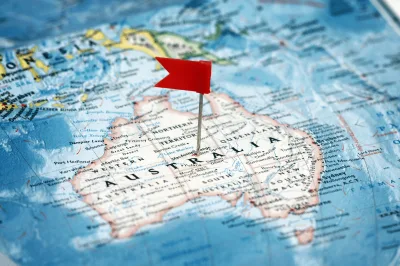On This Page...
ToggleDe Facto Visa Australia: Complete Guide for Couples
By Nilesh Nandan – Australian Immigration Lawyer, MyVisa® Immigration Lawyers
This blog is intended for discussion purposes only and does not constitute advice. You should seek independent legal advice before relying on any information provided on this site.
Immigration policies, systems, and processes can change without notice. I’d like to know your own experience with the immigration challenges noted above — feel free to contact me.
Table of Contents
Introduction
As an immigration lawyer, I meet hundreds of couples each year who are confused about what a “de facto visa” actually is. Many think it’s a separate visa subclass – it isn’t. Rather, “de facto” refers to your relationship type when applying for a Partner Visa in Australia.
If you are in a genuine, committed relationship but not legally married, you may be eligible for a de facto visa under either the onshore (Subclass 820/801) or offshore (Subclass 309/100) Partner Visa pathways. The law recognises your relationship if you can show that you and your partner have lived together for at least 12 months (or less, if registered under State law).
This guide explains everything — from proving your relationship, meeting eligibility, comparing onshore and offshore options, to avoiding costly mistakes that lead to refusals. Whether you’re already in Australia or applying from overseas, my goal is to help you understand exactly what to do and how to do it right the first time.
Understanding the De Facto Visa
The term “de facto visa” is commonly used but technically refers to the Partner Visa subclasses that apply to unmarried couples. Your relationship must meet the Migration Regulations 1994 definition of “de facto partner,” meaning you are not legally married, but have a genuine and continuing relationship and live together (or do not live apart permanently).
What the De Facto Visa Allows You to Do
- Live, work, and study in Australia while awaiting your visa outcome.
- Access Medicare (once the temporary stage visa is granted).
- Travel in and out of Australia freely once on the visa.
- Progress to permanent residence through the second stage of the Partner Visa.
Essentially, this visa recognises and protects genuine relationships that are not yet formalised by marriage, ensuring both partners can live together in Australia lawfully. ([immi.homeaffairs.gov.au](https://immi.homeaffairs.gov.au/visas/getting-a-visa/partner-onshore))
Eligibility Criteria for De Facto Partner Visa
To qualify for a de facto partner visa, you must demonstrate a relationship that satisfies strict legal requirements. These are set out under Regulation 1.09A of the Migration Regulations 1994.
Basic Eligibility Requirements
- You and your partner must be aged 18 or older.
- You must be in a genuine and continuing relationship to the exclusion of all others.
- You must live together or not live apart permanently.
- You must show that the relationship has existed for at least 12 months prior to application unless registered under state/territory law (e.g., NSW Relationship Register).
- Your partner must be an Australian citizen, permanent resident, or eligible New Zealand citizen.
Character and Health
Both partners must meet health and character requirements. This may include police checks from every country lived in for 12+ months and health examinations approved by Home Affairs.
Special Circumstances
There are exemptions to the 12-month rule. For example:
- If your relationship is registered under Australian State or Territory law.
- If compelling circumstances exist (e.g., children of the relationship, humanitarian protection).
- If you could not live together due to workplace, cultural, or visa restrictions but maintained evidence of commitment.
Proof of Relationship – The Core of Your Application
The single biggest reason partner visa applications fail is insufficient or inconsistent relationship evidence. Home Affairs assesses your relationship across four key factors:
- Financial aspects of the relationship
- Nature of the household
- Social aspects of the relationship
- Nature of your commitment to each other
Examples of Acceptable Evidence
| Category | Examples of Evidence |
|---|---|
| Financial | Joint bank accounts, shared bills, joint property lease or mortgage, tax declarations as partners. |
| Household | Shared rental agreements, joint utilities, correspondence to same address, photos of daily life. |
| Social | Photos together at family or social events, invitations addressed to both, statutory declarations from friends/family. |
| Commitment | Long-term plans, wills, superannuation beneficiaries, communication records showing emotional support. |
To strengthen your case, present your evidence in chronological order and include personal statements detailing how your relationship developed. The most convincing applications tell a consistent story supported by documentation.
Onshore vs Offshore De Facto Visa (820/801 vs 309/100)
You can apply for the partner visa as a de facto partner either while you are in Australia (onshore) or from outside the country (offshore). The two streams are structurally similar but differ in timing, processing, and conditions.
| Feature | Onshore (Subclass 820/801) | Offshore (Subclass 309/100) |
|---|---|---|
| Where You Apply | In Australia | Outside Australia |
| Temporary Stage | Subclass 820 (apply and stay in Australia while processing) | Subclass 309 (apply from overseas, may enter once granted) |
| Permanent Stage | Subclass 801 (usually assessed two years after 820) | Subclass 100 (assessed after 309) |
| Work Rights | Full work and study rights after 820 grant | Full work rights after 309 grant |
| Medicare | Eligible after 820 grant | Eligible once in Australia after 309 |
| Processing Time | 16–28 months on average | 15–29 months on average |
| Cost (as of 2025) | From AUD 8,850 | From AUD 8,850 |
| Advantages | Allows you to remain in Australia while waiting | Ideal if you cannot enter Australia yet |
| Disadvantages | Bridging visa delays if previous visa expires | No bridging visa protection before arrival |
For most couples already together in Australia, the onshore route offers convenience and security. However, offshore applications may suit those separated by border, work, or timing constraints.
Step-by-Step Application Process
The de facto partner visa involves two stages — temporary and permanent. You lodge one combined application and pay one fee.
- Confirm eligibility – ensure your relationship meets de facto criteria and that your partner is an eligible sponsor.
- Gather evidence – compile all documents proving your relationship across the four categories mentioned above.
- Create an ImmiAccount – all partner visa applications are lodged online.
- Complete the Partner Visa Application Form – provide accurate details about both partners.
- Your partner lodges the Sponsorship Form (Form 40SP) – this must be done soon after your main application.
- Upload documents – certified copies of passports, evidence, and statutory declarations (Form 888 from witnesses).
- Pay the visa fee – AUD 8,850 (as at 2025), payable once for both stages.
- Receive Bridging Visa (onshore only) – if your current visa expires while awaiting decision.
- Attend health and character checks – police clearances and medical exams.
- Wait for decision – first the temporary stage (820/309), then after ~2 years, the permanent stage (801/100).
For complex cases — e.g., previous visa cancellations or criminal records — seek professional assistance. I’ve represented clients who faced visa cancellations and visa refusals but succeeded on appeal by providing stronger, better-organised evidence.
Processing Time, Cost & Timeline
Cost
- Visa application charge: AUD 8,850 (main applicant).
- Additional applicant (18+): AUD 4,430.
- Additional applicant (under 18): AUD 2,215.
Processing Time (as at October 2025)
- 75% of applications: 16–28 months for Subclass 820.
- 90% of applications: up to 32 months for Subclass 801/100.
Timeline Overview
| Stage | Description | Average Duration |
|---|---|---|
| Preparation | Gathering documents, drafting forms | 1–3 months |
| Application lodgement | Online submission via ImmiAccount | Immediate |
| Bridging Visa (if onshore) | Activates after current visa expires | Varies |
| Temporary Visa Grant | Subclass 820/309 issued | 16–28 months |
| Permanent Visa Stage | Subclass 801/100 assessment | ~24 months after temporary stage |
Common Reasons for De Facto Visa Refusals
Visa refusals often happen not because the relationship is fake, but because the evidence fails to meet legal standards. Common reasons include:
- Insufficient evidence across one or more of the four relationship categories.
- Contradictions in personal statements and witness declarations.
- Failure to meet the 12-month cohabitation requirement or prove exemption.
- Incorrect or outdated statutory declarations (Form 888).
- Inconsistent address or travel records between partners.
- Not disclosing previous visa refusals or cancellations.
- Not providing certified translations for non-English documents.
If your application has been refused, it may still be reviewable at the Administrative Appeals Tribunal (AAT). My team frequently helps clients file successful appeals by fixing the evidence gaps that led to the initial refusal.
Real-Life Scenarios & Legal Insights
Case 1 – Student and Australian Citizen
Maria, an international student from Brazil, began living with her Australian partner while finishing her degree. They applied for the onshore de facto visa before her student visa expired. By showing joint bank accounts, shared lease, and social evidence, her 820 was granted within 20 months. She later obtained permanent residency under subclass 801.
Case 2 – Couple Living Apart Due to Work
Sanjay worked in Perth while his partner Priya was posted interstate. They saw each other monthly and maintained a joint bank account. Though living separately, they documented constant communication and registered their relationship in NSW, meeting exemption requirements. Their offshore application was approved after 24 months.
Case 3 – Visa Refusal Overturned
A de facto visa for a same-sex couple was initially refused due to inconsistent timelines in their statements. Upon appeal, we demonstrated the relationship history with additional witness declarations, digital communication logs, and statutory declarations correcting the errors. The AAT set aside the refusal and the visa was granted.
Evidence & Document Checklist
Before submitting your application, ensure you have the following:
- Identity documents (passports, birth certificates, photos).
- Relationship evidence: financial, household, social, and commitment proof.
- Police clearances for both partners.
- Health check results (authorised panel physician).
- Form 888 declarations from two or more Australian citizens or PRs.
- Proof of sponsor’s citizenship or PR status.
- Relationship registration certificate (if applicable).
- Translations of non-English documents.
- Cover letter summarising relationship and evidence.
Frequently Asked Questions
- How long does it take to get a de facto visa in Australia?
Processing times vary, but most onshore applications take 16–28 months for the temporary stage, and permanent stage follows about two years later.
- How much does the de facto visa cost?
The visa charge starts from AUD 8,850 for the main applicant, plus additional charges for family members.
- What happens if my relationship ends before the permanent stage?
Your visa may be cancelled unless there are special circumstances such as domestic violence or a child of the relationship.
- Can my de facto visa be refused under Section 501 (character grounds)?
Yes. If you fail the character test under Section 501 of the Migration Act 1958, your visa can be refused or cancelled. Seek legal representation immediately.
- Can I apply if we have not lived together for 12 months?
Yes, if your relationship is registered in an Australian state or there are compelling circumstances like having a child together.
- Do I need to be onshore for the permanent stage?
- Yes, for subclass 801, you must be in Australia at the time of decision; for 100, offshore at the time of decision.
Book a Consultation
The de facto visa process can feel overwhelming — but with the right guidance, it doesn’t have to be. I’ve helped thousands of couples navigate this complex area of law successfully, even after refusals or cancellations.
Book a consultation with me today to discuss your visa situation.
For further resources, visit Visa Refusals, Visa Cancellations, Partner Visas, and Contact MyVisa to arrange your consultation.
Legal Disclaimer
By Nilesh Nandan — Australian Immigration Lawyer, MyVisa®️ Immigration Lawyers
This blog is intended for discussion purposes only and does not constitute advice. You should seek independent legal advice before relying on any information provided on this site. Immigration policies, systems, and processes can change without notice. I’d like to know your own experience with the immigration challenges noted above — feel free to contact me.
MyVisa: Nilesh Nandan, Attorney at Law
BBus(Accy) LLB(QUT) GDLP MBA(IntBus)
Head of Practice





523 Responses
Hi..
Is it possible to legally register De facto relationship if my partner is in legally married and has not permanently ended his marriage. I mean he is not intend to divorce his wife..I’m an Indonesian and he is an Australian citizenship. We’ve been t in a relationship more than 2years and i can proof it And now i’m 4months pregnant by him. I have a multiple tourist visa and allowed to stay there for maximum 3months. So since last 2019 i came and out from Australia many times. But because the international border is still closed i cant fly there.
Thank you Nilesh and have a good day
The rules full registration of civil partnerships or any de facto relationship differ from state to state and territory.
I’m not aware of any state or territory that will allow a defacto relationship to be registered where one party is still married to a third party.
in your case you say that you have been in a defacto relationship for at least two years and you have “proof” of that. This means that you will be able to rely on the basis of the 12-month rule. If you’re not married or if you do not have a relationship certificate then you need to be in a defacto relationship to the exclusion of all others for a period of 12 months to meet your prior to making the application for a partner visa.
You should get specific advice about your circumstances before making an application.
Thank you for your question and I hope that my preliminary comments have been useful.
Regards
Nilesh Nandan
Hi Nilesh,
Thank you for giving us helpful advice!
Our couple is having a depressing time away from one another, please help us out.
Currently I’m in my country, South Korea finishing my degree and my partner is in Australia – he is an Australian citizen.
We were planning to apply for the onshore partner visa this year after I enter Australia with working holiday visa or ETA. But due to the pandemic, the Australian border is closed before I finish my degree, and we are considering applying for the exemption in June when I’m ready to fly into Australia.
We have registered our relationship at NSW in August, 2019 and we opened up our joint account in November 2018, but we haven’t applied for partnership visa nor married because we have been in a long-distance relationship.
My question is – 1) given that we registered our relationship at NSW, how likely is it that the Australian government would grant me the travel exemption?
2) I’m thinking of applying for ETA or working holiday visa along with the exemption application, would the type of the visa I choose affect their decision on whether they grant me the exemption or not?
3) If Australian government rejects me to enter Australia, what will be the way for us to see each other? :'(
I hope my questions are clear for you to understand.
Thank you very much in advance.
Apologies for my slow reply Hailey. Thanks for such detailed information. We really need to talk it through so I suggest you book in a 10-minute chat to discuss with me: https://myvisa.com.au/book/
Hi Nilesh,
Hop you doing well!
Quick question.
My partner has been invited for a 190 visa December 2019 and she applied on February this year. She is going to add me as her de-facto in her application. Now, we have been less than 12 months together, so we send the papers for registration around 3 weeks ago.
The problem is that her visa waiting period got reduced from 7-9 months to 5-7 months, so now we’re afraid that is going to be granted before the de-facto certificates arrives.
Is it possible to make a change of circumstances in her visa now and upload the certificate later once we receive it? Or is it required to have the exact date where we became registered de-facto for her to do a change of circumstances in her application?
Thank you!
The are a number of issues here. You should consider getting detailed advice. But for present purposes, you should note:
1. The rules for being a defacto partner in a defacto relationship aren’t the same in 190 applications and 820 applications.
2. Your visa status and other eligibility for the 190 is to be considered.
The short answer to your question however is that you should update Immigration immediately and supplement the immi account with the certificate as soon as it comes in.
Do see me if you require additional support.
Best
Nilesh Nandan
Hi , I have a question.
Im holding a student visa and my partner he holding a australian citizenship .I have been live together with him and his mom. He used to work as a causal job but unfortunately about corona virus outbreak then he lost a job ,now he getting a centralink Coronavirus supplement package .if it possible that he can sponsor me a defecto visa while he has no job?(we registered a relationship certificate )
We live together 3 year but all the bill it under his mom also she is a owner of a small restaurant .
Thank you ,
Yes. I would lodge. The current rules for defacto partner visas are as good as they are likely to ever get. I’m sure the employment situation with resolve itself by the time the defacto sponsor application is considered. I wish you both then best.
Nilesh Nandan
Hi,
My partner is from New Zealand and I’m from Canada. We’ve applied for the 461 visa in July 2019! We’ve been together for almost 4 years (met in NZ, moved over here together) and have been living together for about 3 years. We’ve sent it enough evidence to prove everything that was asked. Just wanting to ask whether I should keep sending in more documents or just wait and not bother? Will it speed up the process or delay it?? Since we’ve sent our application in, We’ve been on a couple of important trips together, moved into our own place (we were house sharing before), and we have also applied for civil partnership. Will it help to send in this additional evidence?? Thanks!
Thanks for sharing your experience and frustration.
I would get a glass of wine and forget about immigration for the moment.
If you don’t do this you’re likely to go crazy drip-feeding immigration with every additional bit of information for many many months ahead.
If you have confidence that you have got enough evidence to show that you are in a genuine and continuing relationship then relax and have a second glass.🍸🍷
When your case is opened by the case officer it is my experience that in all cases you will receive a letter from them, asking you to provide updated or additional material.
Until then, I would not waste your precious time unless you really really ♥️ love uploading stuff into your immi account.
Hi, I have a question regarding processing times, in particular temporary grant of visa to permanent grant of visa. Is the two year period for consideration of permanent residence from the moment you make your overall application or from when you are granted the temporary visa?
This is a great question.
The two year period starts at the time you make the application for the provisional partner visa subclass 820 or subclass 309.
Subclass 820 is the onshore version and subclass 309 is the offshore version.
You are eligible for permanent residency after you have been together for a 2 year period starting from the date of lodgment… Not from the date of decision and not from the date your relationship commenced.
Note that even though you are eligible for permanent residency, it usually takes a few months before information requests are made and processed by DHA …to confirm that you are still in a genuine and continuing relationship, prior to the permanent resident visa grant being made.
In the case of the case of onshore applications, you will then be granted a subclass 801 permanent resident visa. If the partner visa was originally made offshore as a subclass 309 then you will be eligible for the grant of the subclass 100 while you are on shore.
Hi Nilesh,
My partner and I have been together for 2 and a half years, we have had a shared lease since July 2019 in the UK, and before that we were living with my parents from October 2018. I have already lodged a de facto partnership visa – we haven’t registered our relationship as we have a lot of evidence to back our relationship.
In September 2019 I applied offshore for my partner visa and our plan was to travel Europe from August 2020, as this is when his visa expires for the uk, until my visa was granted for Australia. With the wait time currenly at 13-21 months that would mean travelling until anywhere between October 2020 and June 2021 which we are well prepared for. Obviously COVID19 is having a huge affect on our plans and I applied for an exemption to travel, to which they said I need to hold a visa and they can’t bring my previously lodged visa forward, which is okay because I am eligible for a working holiday visa which brings me onto my query.
Would I be okay to head there on a working holiday visa because I applied for my visa offshore I am concerned what issues I will run into if I am in Australia when my partner visa is granted. Is it a case of heading to New Zealand and coming back to validate that visa or can I not be in the country at all?
Thanks
Great question.
The offshore subclass 309 version of the partner visa can only be granted if you are offshore.
Nothing stops you from entering Australia on a visitor visa or a working holiday visa.
At the time DHA is ready to grant your 309 visa, they will check their systems and if you are inside Australia, typically contact you or your agent and explain that they are ready to make it grant …and give you an opportunity to exit (to New Zealand as you have suggested in your question) so that they make the 309 grant to you.
If this clear?